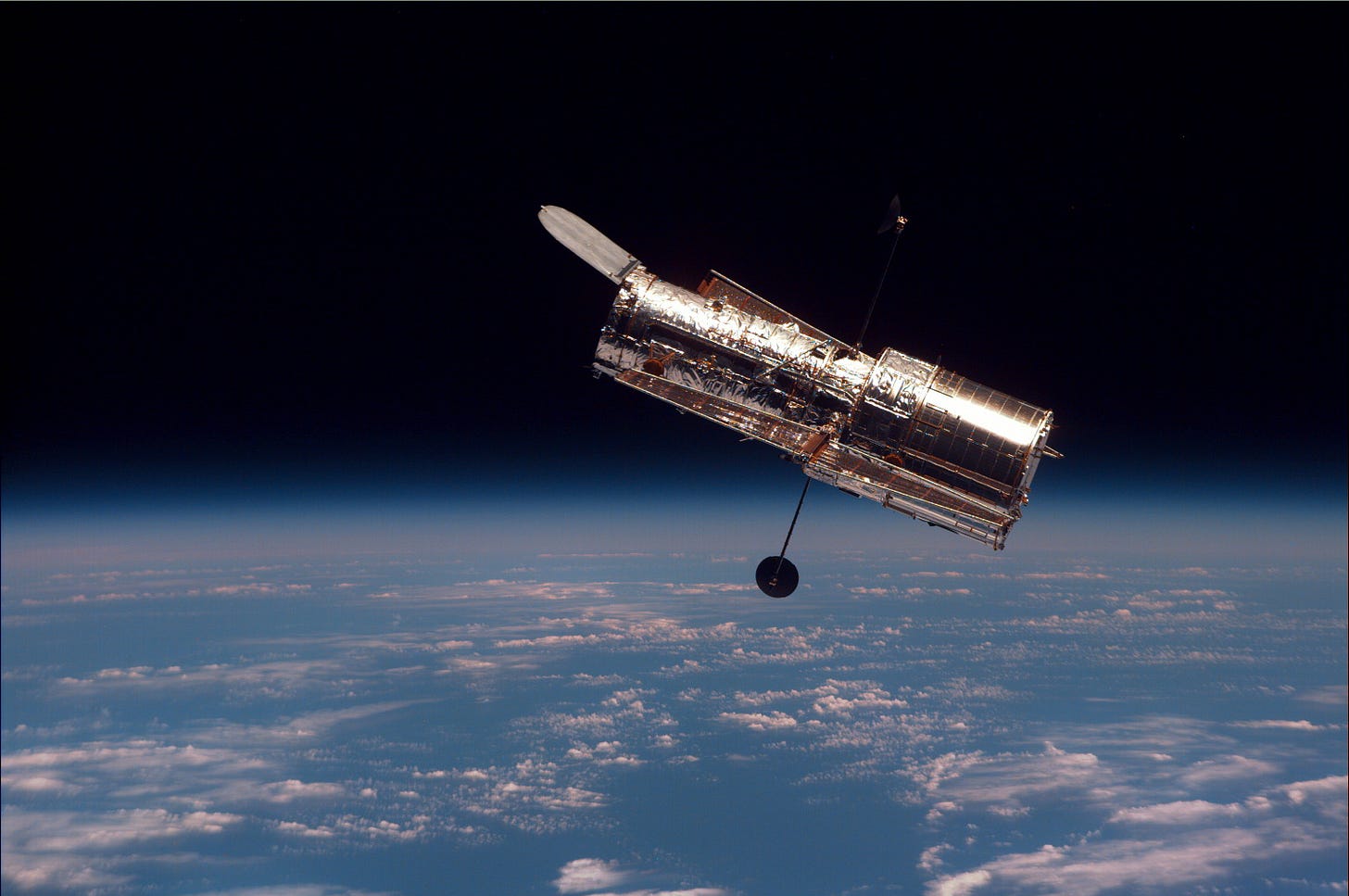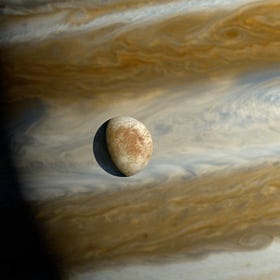Hubble Is Getting Old. Should We Try to Save It?
On the future of the Hubble Space Telescope.
Some think Hubble will die quickly.
If it does, it will probably be the fault of the gyroscopes it carries onboard. There are six of these, and they are essential to keeping the telescope running. But they are failing, and over the fifteen years since they were last replaced, four have ceased to function properly. The two that are left are carefully managed by NASA, and their analysis suggests they should last for a few more years.
But when they fail – perhaps tomorrow, perhaps ten years from now – it will spell the end for Hubble. Without its gyros, the telescope cannot control its attitude. It cannot point at the stars, and before long it would tumble out of control. Its scientific career, from that point onwards, would be over.
Others, NASA included, hope for a slower demise. Over time, the telescope is falling, tracing a long descent back to Earth. Between 2002, the last time the orbit of Hubble was raised, and 2022, the telescope lost only forty kilometres of altitude. But this loss is now accelerating – since 2022, indeed, Hubble has lost another forty kilometres. It now never rises more than five hundred kilometres above the Earth’s surface.
This fall may slow slightly in the coming years. Part of the recent acceleration came thanks to a more active Sun, which tends to heat and expand the upper atmosphere, and thus to drag things back to Earth more quickly. But this trend is now in reverse, and as the Sun quietens, Hubble’s descent should slow too. But at some point – and estimates here range from 2029 to 2035 – the fall will become fatal.
Yet it is not too late for Hubble. The telescope may be dying, but it is not dead yet. And that raises a question: what should we do with Hubble? Should we abandon it to its fate, and accept that an ageing telescope must die eventually? Or should we try to save it, and prolong its life as astronauts have done in the past? Should we even try to preserve it, and keep it as a treasured possession of humanity?
I. Reentry
Hubble’s falling altitude, as things stand, is its most troubling problem. Gyros can be replaced – and although this is not an easy operation, the telescope could be put into a safe mode until astronauts are ready to conduct a repair. But once the observatory falls too low – and some reports suggest we may already be at that point – repair becomes far more difficult to conduct.
At fault is the Earth’s atmosphere. Though its thickest layers, the troposphere and stratosphere, linger close to the planet’s surface, its outer layers extend hundreds of miles upwards. The slight density of these layers exerts a slow drag on orbiting spacecraft, and slowly saps them of the energy they need to stay in orbit.
Over time, then, most spacecraft gradually fall. This is an accelerating process – the more a satellite falls, the more air it encounters, and the more drag it experiences. Eventually, after its altitude drops below about three hundred kilometres, maintaining an orbit becomes impossible. Instead the spacecraft plunges towards the surface and burns from the heat of reentry.
This, if nothing is done, will be the fate of Hubble. But there is a twist: parts of Hubble are likely to survive reentry. NASA is particularly concerned about its large mirror, a big chunk of which they think could hit the ground. This might be dangerous: indeed, NASA calculates the observatory has about a one in two hundred chance of killing someone. This is small, but rather higher than the one in ten thousand threshold normally demanded for a safe reentry.
Perhaps, an early study for NASA proposed, we could fire a missile at Hubble as it neared the moment of re-entry. This would blow the observatory to smithereens, ensuring, they initially thought, that no large chunks of it would hit the ground. But detailed calculations suggested that big pieces of the mirror might still survive, and, indeed, that the resulting cloud of shrapnel might prove more dangerous than the telescope itself.
Instead of firing a warhead, then, NASA has vague plans to deorbit Hubble. This would likely require the agency to send a special vehicle to dock with the observatory. Once in place it would steer the telescope back to Earth, and then make sure any surviving pieces fall into the depths of the Pacific Ocean, rather than on someone’s head.
But whether this will really happen is uncertain. NASA has released no plans to build such a vehicle, and though they still have some time, they would need to start work on one soon. But, short of cash and time, it seems they may eventually be forced to accept the risk of reentry, and simply hope that Hubble doesn’t take anyone else with it on the way out.
II. Repair and Reboost
The thing is, if we could send a vehicle to bring Hubble down, we could also send a vehicle to raise it up. This would make more sense – after all, why should we allow one of the greatest observatories in human history to die any sooner than it should?
And, in principle at least, there is nothing especially difficult about such a mission. The vehicle could be fully robotic, so no astronauts are put in danger, and it could make use of a docking ring installed on Hubble by its last servicing mission. In principle – although the engineering challenges of doing so are high - the vehicle could also take over some of the attitude control of the spacecraft, at least partially solving the problem with its gyros.
So why don’t we do this?
One reason is cost. Building such special vehicles tends to be expensive, and NASA is already facing steep budget cuts. The money to keep Hubble running is fortunately still there, but nothing is available to extend its life.
But the other reason is risk. As long as Hubble still works, its operators are unwilling to do anything that might damage it. A robotic mission to raise its orbit might seem simple enough, but such a craft would need to operate with extreme care around the observatory. And few similar missions have ever been executed before.
This, indeed, was the argument that doomed another mission proposed by the billionaire astronaut Jared Isaacman. He suggested sending a crew of astronauts to visit the observatory using SpaceX’s Dragon capsule. Through a series of spacewalks, those astronauts could repair Hubble, he said, and switch out its gyros. And Dragon’s thrusters could raise it to a higher orbit, and so extend its lifetime.
But after studying the proposal, NASA said no. The risks to the telescope were likely the biggest reason why. And, indeed, damaging Hubble is a big risk – even trained astronauts from NASA have accidentally broken parts of it before. Somewhat understandably, the agency was not happy about having a bunch of semi-professional astronauts visiting their prized observatory.
Still, that doesn’t mean they will always say no. Indeed, it is easy enough to imagine a scenario in which Hubble’s gyros do suddenly fail, and public pressure mounts to conduct a repair. With the telescope out of action, the risks of damaging it are inconsequential, and the benefits of repair huge. If the money could be found, Hubble might get the mission it needs – and NASA, really, should already start planning how it could be carried out.
III. Replace
Hubble, it is sometimes said, is a spy satellite that looks up instead of down. There is some truth in this claim. The telescope was built in the 1980s using technologies developed for military espionage. Most tellingly, its mirror - 2.4 metres across – is nearly identical to those probably used by the clandestine KH-11 satellites.
But if it is a spy satellite, it is an old one. Today’s technology has moved far beyond that of the 1980s. If we wanted to, and if we chose to once again look up instead of down, we could build a far more capable replacement.
Indeed, a decade ago, one of America’s spy agencies donated two large mirrors to NASA. They were surplus, apparently, to the needs of espionage, and so NASA got the opportunity to repurpose them for science. But despite this offer, neither of the two mirrors has yet left Earth.
Fortunately that should soon change: one of the two has been installed in the Nancy Grace Roman Telescope, and should, barring a last-minute cancellation, be sent into space by 2027. And, in many ways, this observatory could be thought of as a worthy successor to Hubble. It will be capable of taking similar quality photographs, and of surveying more of the sky.
But as for the other mirror, there are no definite plans. NASA has, at times, considered making it part of a telescope that would orbit Mars, or that would devoted to studying the solar system. But with no plans and no money, it will likely remain in a warehouse for another decade or so.
This all highlights a few sad facts about America’s space telescopes. First, that the costs of building them are such that new ones are rare indeed. Second, that there are almost certainly a dozen or so telescopes with greater power than Hubble pointed downwards, towards the world of men and machines, rather than upwards, towards the cosmos of galaxies and stars. And third, that Hubble is getting old, and there are few serious plans to prolong its life any further.
And that, given both the scarcity of such Hubble-class observatories and the technological achievement of building one at all, is a real shame.
Read More
The Europa Clipper: Are There Oceans On The Second Moon of Jupiter?
Due to personal commitments I have not been able to write a full article this week. Instead I am making this article, previo…
How Dust on the Ocean Floor Hints at a Recent Near-Earth Supernova
However big you imagine a supernova to be, the reality is certainly bigger. To put it one way, an exploding star can briefly outshine the combined light of every other star in a galaxy; to put it another, a supernova at the distance of Pluto would hit you with more energy than a hydrogen bomb exploding just outside your front door.
What Lies Beyond: Exploring Interstellar Space
The scale of things is hard to grasp. The distance from Earth to the Moon - some four hundred thousand kilometers - is the shortest cosmic scale of any significance, but one that already stretches th…





The maintenance of something like this is very expensive… and it would be reasonable to replace it… which is even more expensive…
By the way, is Hubble the only telescope that was serviced in orbit…?
Anyway, it's a little ironic (maybe not the right word) that we put telescopes in orbit to get them above the atmosphere, but then they fall back to earth because of the wispy, outermost fringes of the atmosphere… it's very frustrating.
It may be naïve, but wouldn’t another option be to turn one of the down pointing mirrors up?